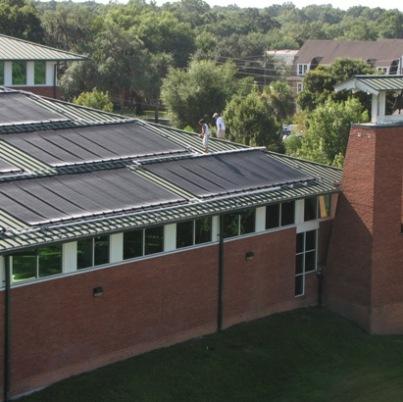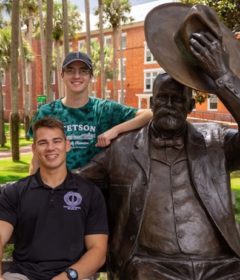CO2 emissions drop 21 percent

Stetson University has reduced its carbon footprint by 21 percent since 2009 – thanks to strategic efforts to conserve energy, make the campus more pedestrian- and bicycle-friendly, use more eco-friendly products for landscaping and utilize cleaner transportation.
A new study by Stetson students and Associate Professor of Geography and Environmental Science J. Anthony Abbott shows Stetson’s annual carbon footprint weighs 13,193 metric tons of carbon dioxide (CO2) emissions.
Results of the carbon audit study will be presented at a free public forum, “Assessing and Approaching Sustainability at Stetson University,” at 6 p.m. Tuesday, Feb. 7, at the Rinker Environmental Learning Center, 231 E. Michigan Ave., DeLand.
Stetson students led by Abbott have now conducted three carbon audits for the university (done every other year). The latest findings, for the fiscal year that ended June 30, 2011, shows Stetson’s CO2 emissions have declined 29 percent since the first carbon audit, for fiscal 2007, and 21 percent since the second carbon audit, for fiscal 2009.
“We’re very excited to see how well energy efficiency initiatives have paid off in terms of carbon reduction and total amount of energy used,” Abbott said.
“It reinforces that all of us can do something about this, in terms of the miles we drive and the kind of car we drive, and how we use electricity,” said Al Allen, associate vice president for Facilities Management at Stetson.
A greenhouse gas inventory is required by the American College and University Presidents Climate Commitment, a pledge Stetson made in 2007. As a signatory, Stetson is committed to working toward carbon neutrality.
Beginning this year, Stetson also plans to participate in the Sustainability, Tracking, Assessment & Rating System (STARS) administered by the Association for the Advancement of Sustainability in Higher Education. Nearly 230 institutions of higher education have registered for the program designed to encourage sustainability in all aspects of higher education.
The university used The Campus Carbon Calculator – the tool favored by most U.S. universities and colleges – for its carbon audit study. In an academic course taught by Abbott, the students studied such items as fuel consumption, energy purchases, amount of natural gas burned on campus and fertilizer use. They surveyed the campus community about driving habits and commuter patterns.
For fiscal 2011, the team discovered the largest single source of emissions is electricity, followed by commuter travel, then natural gas combustion, then business travel. Compared to the 2009 audit, emissions from electrical production have decreased 23 percent. Campus fleet fuel, solid waste and fertilizer emissions also declined significantly, while natural gas usage increased slightly.
Students, faculty and staff have worked together over the past six years to assess sustainability at Stetson and to begin developing a climate action plan for the future. Initiatives implemented thus far include installation of efficient lighting, electronic ballasts and window film; temperature setbacks; solar for heating the swimming pool and some outdoor lighting; installation of LED lighting in parking areas; and elimination of hot water for laundry in most residence halls. An electric car was purchased to replace an SUV used by university Public Safety, and the university converted to diesel-powered utility carts. The university is migrating from synthetic products to organic for fertilization and weed-control.
Last August, all students were provided with a brochure on how each of them could make a difference in terms of conserving energy.
“Turn off lights, turn off fans, change temperatures, install better lighting, use cold water for laundry. It’s awareness and confidence that makes a difference,” Allen said. “People want to know what to do. Take advantage of technologies and increase awareness.”
While the overall campus community learned the basics, the students conducting the study gained the most knowledge – and invaluable real-world experience.
“This allows students to see how they can engage in climate-change mitigation in the workplace in an applied way,” Abbott said. “They learn how to track it in their daily life. They learn how to do climate-change mitigation, as opposed to just reading about it.”



